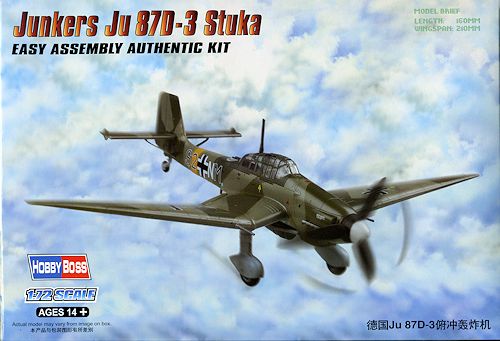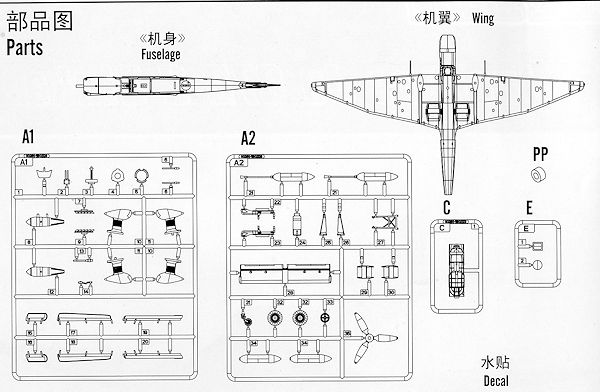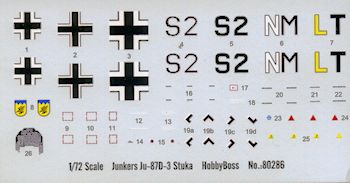
Hobby Boss 1/72 Ju-87D-3 Stuka
| KIT #: | 80286 |
| PRICE: | $15.99 SRP |
| DECALS: | Two options |
| REVIEWER: | Scott Van Aken |
| NOTES: | Easy Assemble kit |

| HISTORY |
The Junkers Ju 87 or Stuka (from Sturzkampfflugzeug, "dive bomber") was a two-man (pilot and rear gunner) German dive bomber and ground-attack aircraft. Designed by Hermann Pohlmann, the Stuka first flew in 1935 and made its combat debut in 1936 as part of the Luftwaffe's Condor Legion during the Spanish Civil War.
The aircraft was easily recognisable by its inverted gull wings, fixed spatted undercarriage and its infamous Jericho-Trompete ("Jericho Trumpet") wailing siren, becoming the propaganda symbol of German air power and the blitzkrieg victories of 1939–1942. The Stuka's design included several innovative features, including automatic pull-up dive brakes under both wings to ensure that the aircraft recovered from its attack dive even if the pilot blacked out from the high acceleration.
Although sturdy, accurate, and very effective against ground targets, the Ju 87 was vulnerable to modern fighter aircraft, like many other dive bombers of the war. Its flaws became apparent during the Battle of Britain; poor manoeuvrability and a lack of both speed and defensive armament meant that the Stuka required heavy fighter escort to operate effectively.
The Stuka operated with further success after the Battle of Britain, and its potency as a precision ground-attack aircraft became valuable to German forces in the Balkans Campaign, the African and Mediterranean theaters and the early stages of the Eastern Front campaigns where Soviet fighter resistance was disorganised and in short supply.
Once the Luftwaffe had lost air superiority on all fronts, the Ju 87 once again became an easy target for enemy fighter aircraft. In spite of this, because there was no better replacement, the type continued to be produced until 1944. By the end of the conflict, the Stuka had been largely replaced by ground-attack versions of the Focke-Wulf Fw 190, but was still in use until the last days of the war. An estimated 6,500 Ju 87s of all versions were built between 1936 and August 1944.
Oberst Hans-Ulrich Rudel was the most notable Stuka ace and was the most highly decorated German serviceman of the Second World War. On 29 December 1944, he became the only serviceman to receive the highest German military award, the Knight's Cross with golden Oak Leaves, Swords and Diamonds.
Despite the Stuka's vulnerability to enemy fighters having been exposed during the Battle of Britain, the Luftwaffe had no choice but to continue its development, as there was no replacement aircraft in sight. The result was the D-series. In June 1941, the RLM ordered five prototypes, the Ju 87 V21–25. A Daimler-Benz DB 603 powerplant was to be installed in the Ju 87 D-1, but it did not have the power of the Jumo 211 and performed "poorly" during tests and was dropped. The Ju 87 D-series featured two coolant radiators underneath the inboard sections of the wings, while the oil cooler was relocated to the position formerly occupied by the coolant radiator. The D-series also introduced an aerodynamically refined cockpit with better visibility and space. In addition, armor protection was increased and a new dual-barrel 7.92 mm (.312 in) MG 81Z machine gun with an extremely high rate of fire was installed in the rear defensive position. Engine power was increased again, the Jumo 211J now delivering 1,420 PS (1,044 kW, 1,401 hp). Bomb carrying ability was nearly quadrupled from 500 kg (1,100 lb) in the B-version to 1,800 kg (3,970 lb) in the D-version (max. load for short ranges, overload condition), a typical bomb load ranged from 500-1,200 kg (1,100-2,650 lb).
The internal fuel capacity of the Ju 87D was raised to 800 L (of which 780 L were usable) by adding additional wing tanks while retaining the option to carry two 300 L drop tanks. Tests at Rechlin revealed it made possible a flight duration of 2 hours and 15 minutes. With an extra two 300 L (80 US gal) fuel tanks, it could achieve four hours flight time.
The D-2 was a variant used as a glider tug by converting older D-series airframes. It was intended as the tropical version of the D-1 and had heavier armour to protect the crew from ground fire. The armour reduced its performance and caused the Oberkommando der Luftwaffe to "place no particular value on the production of the D-2". The D-3 was an improved D-1 with more armour for its ground-attack role. A number of Ju 87 D-3s were designated D-3N or D-3 trop and fitted with night or tropical equipment. The D-4 designation applied to a prototype torpedo-bomber version, which could carry a 750–905 kg (1,650-2,000 lb) aerial torpedo on a PVC 1006 B rack. The D-4 was to be converted from D-3 airframes and operated from the aircraft carrier Graf Zeppelin. Other modifications included a flame eliminator and, unlike earlier D variants, two 20 mm MG 151/20 cannon, while the radio operator/rear gunner's ammunition supply was increased by 1,000 to 2,000 rounds. Nearly 1600 D-3 variants were produced.
| THE KIT |
 In line with
others in this series, Hobby Boss has worked to provide what is needed in as few
a number of parts as they could. This means that the lower fuselage incorporates
the one piece wings while the upper fuselage has the fin. The cockpit tub is
also incorporated in the upper fuselage section. One simply inserts the pilot's
seat, control stick and the rear gun into the tub. No rear gunner's seat is
provided. A clear lens for the DF antenna build into the upper fusleage is
supplied.
In line with
others in this series, Hobby Boss has worked to provide what is needed in as few
a number of parts as they could. This means that the lower fuselage incorporates
the one piece wings while the upper fuselage has the fin. The cockpit tub is
also incorporated in the upper fuselage section. One simply inserts the pilot's
seat, control stick and the rear gun into the tub. No rear gunner's seat is
provided. A clear lens for the DF antenna build into the upper fusleage is
supplied.
The horizontal tail is trapped between the fuselage halves and the other sundry bits like the tailplane braces, lower wing radiator housings, flaps and ailerons, the bomb in its crutch and the spatted landing gear are then attached. Unlike other kits, this one has a separate tail wheel. Exhaust stacks and the wing guns are a separate item as well. There is a one piece canopy that fits atop the cockpit. The clear window in the lower forward fuselage through which the pilot looks during a dive is also included.
There is something missing, and those are the dive
brakes. The D-3 did have them removed from time to time, but judging from the
photos I've looked at, it usually had them. Now these may have been omitted as
the kit includes the 37mm cannon pods used by the Ju-87G, and that versio n
did not have dive brakes. I should add that there are no outer wing bomb racks
or bombs either.
n
did not have dive brakes. I should add that there are no outer wing bomb racks
or bombs either.
Instructions are well done with a variety of paint references. Markings are for two aircraft, both with St.G. 77. The box art plane is in the standard scheme of RLM 70/71/65 with a yellow fuselage band and lower outer wing tips. The other is in a similar scheme but with a white winter camo on the upper portion of the airframe. The swastika is included, but in four separate parts, so you may want to dig up your aftermarket swastika decal sheet for this one.
| CONCLUSIONS |
Judging from the look of things, I would have to put this one pretty much on a par with the older Fujimi kit in terms of detail, though the Fujimi engraving will be a bit softer than on this newer kit. However, the Fujimi kit will include the dive brakes. I would not consider this one to be a replacement for the older kit, but more of a companion.
| REFERENCES |
http://en.wikipedia.org/wiki/Ju_87
April 2013
Thanks to Squadron Products for the preview kit. You can find this one at your favorite hobby shop or on-line retailer.
If you would like your product reviewed fairly and fairly quickly, please contact the editor or see other details in the Note to Contributors.